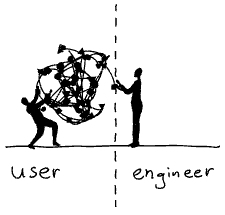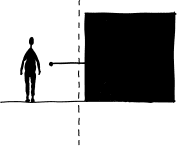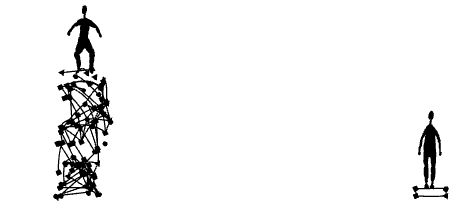Make me think
Design complexity
Until recently, the things we use on a day-to-day basis took shape on the basis of their technological basis. Constructive design of the phone was reduced mainly to the creation of the body around the car. The task of the designers was to make the technology look more beautiful.
Engineers defined the interfaces of these things. Their main task was the functionality of the machine, and not the simplicity of its use. Users had to figure out through trial and error how it all works.


')
With the discovery of every technological innovation, our household items became more and more equipped and much more complex. Designers and engineers simply burdened users with a similar increase in complexity. I still have nightmares about trying to get a train ticket using the old BART vending machine in San Francisco.

From complicated to simplicity
Fortunately, UX-designers (User eXperience) have found ways to develop beautiful interfaces that are also easy to use. This process is reminiscent of a philosophical conversation in which questions such as are constantly being asked: What is it really? How do we perceive it? What is our model of thinking?

Today, thanks to their efforts, we are interacting with well-designed interfaces. Designers "tamed" the complexity of technology for us. Extremely complex technologies now seem simple and easy to use.

From simple to elementary
And ease of use sells well. Therefore, more and more sales offers are based on a promise to make our lives easier, using more and more complex technologies, but with a simpler interface.

Just tell your smartphone what you want, and everything will appear as if by magic - whether it is the necessary information on the screen or a package with products delivered to your door. A huge amount of technology and infrastructure "domesticated" for users of courageous designers and engineers who do all this work.

But we do not see - not to mention understanding - what is going on behind the scenes, what is going on behind a simple interface. The user is in the "dark" ignorance.

I, like many users, start whining like a naughty child when video calls do not work as smoothly as expected - all these interruptions and poor sound quality! An event that seemed to be nothing more than a miracle for people only 50 years ago, and which requires a colossal infrastructure, became an expected norm for me, no longer appreciated, including because we do not understand what is happening.
Does this mean that technology makes us stupid? This question is not new at all. It is known that arguments about such effects agitated the minds of philosophers already in the days of ancient Greece.
Design problems with user orientation ( “user-centered” design )
In his book “Living with complexity”, Donald Norman offers many strategies for how designers can tame complexity in order to improve user experience.
This is some problem. I am increasingly afraid of the term “user-centered design”. The word "user" is also used in legal vocabulary in the sense of "drug user", which means dependence, short-sighted satisfaction of needs and a reliable source of income for the "dealer". The word “centered” excludes almost everyone and everything else.

An integrated approach to complexity
Alternatively, we should take a broader look at the world and ask the following questions:
Empowerment: Who really has a good time?
Perhaps the ability to speak a foreign language is more fun than using translation software.
Whenever we are going to replace painstaking activities, such as learning languages, cooking food or caring for plants with a deceptively simple solution, we should always ask ourselves: should technology be developed in this way - or does the personality become “user”?

Sustainability: Will it make us more vulnerable?
High-tech systems work flawlessly, as long as everything goes as expected. When a situation arises that the developers did not foresee, these systems become vulnerable. The more complex the system, the higher the likelihood that things will go wrong. Such systems are less stable.

Chronic dependence on a combination of electronics, artificial intelligence systems and high-speed communication channels to solve the simplest tasks is a recipe for disaster. It complicates our lives, especially when we do not understand what is going on behind a deceptively simple interface.
Empathy: what is the impact of these simplifications on others?
Our decisions have implications for both ourselves and others. Simplified appearance can create an illusion, make us blind to such consequences.

Our decisions have a huge impact on life. Understanding complexity can be of tremendous value. We need to know and understand better, “how it works,” in order to improve, clearly seeing the results of our actions and what led us to them.
Openness to complexity
Simplification is a powerful design strategy. Naturally, the emergency call button should be as simple as possible. And yet, we also need new design strategies that help us make decisions, interacting with understanding with difficult situations in our lives.
Comment Cloud4Y
This article caught our attention with its relevance. Although, with rare exceptions, we are representatives of the b2b sector, an integrated approach to designing complex systems proposed by the author is similar to our idea of the desired quality of service.
Empowerment. Cloud services Cloud4Y meet high requirements for the level of manageability. Clients get the ability to virtually complete self-service in their easily configurable virtual data center (vDC) through VMware vCloud Director 9.0, which has a convenient HTML5 interface.
Sustainability. Thanks to the Cloud4Y cloud infrastructure architecture, the problems of Geo and Catastrophe-Resistance are solved. To ensure guaranteed availability, the Tier III data center network is integrated with a high availability optical ring. Due to the storage of personal data of users, data centers, including a remote backup data center, are located in Russia. The default VMware High Availability feature and network protection of the provided infrastructure against attacks from the Internet and hacking attempts are used.
To work with "heavy" software that requires high-performance video cards, including designers, in our cloud is available GPU (cloud graphics) on the VMware virtualization platform.
Source: https://habr.com/ru/post/349196/
All Articles